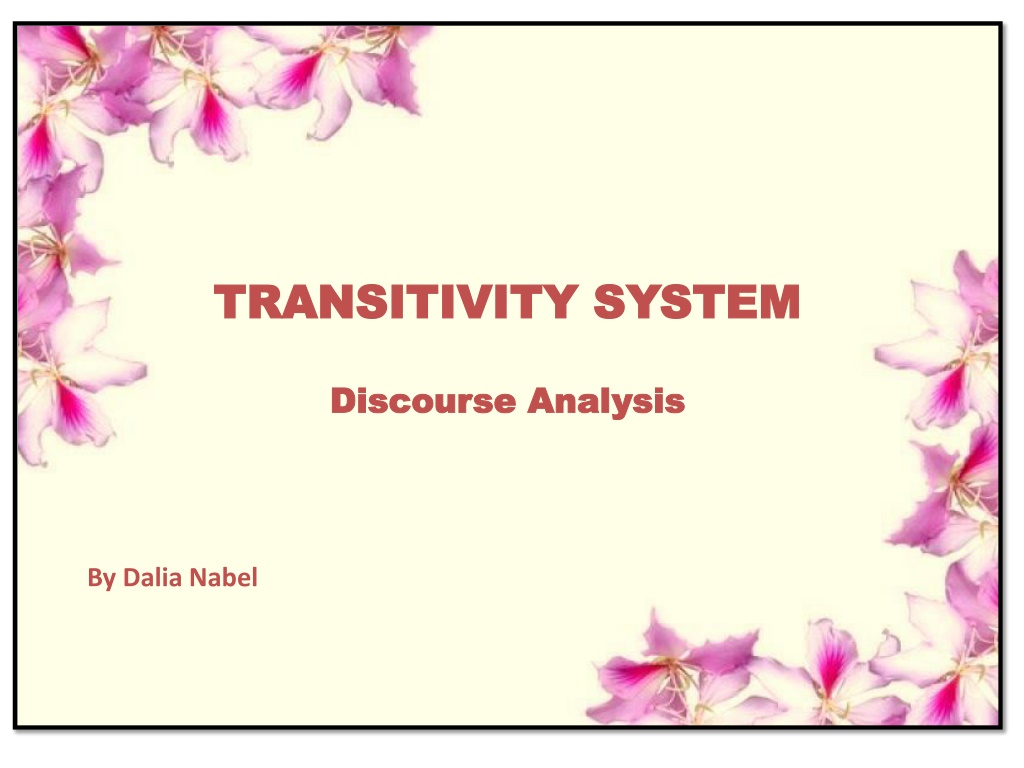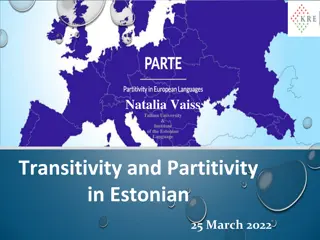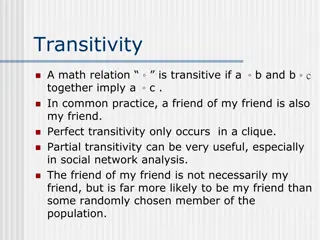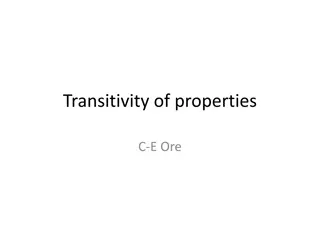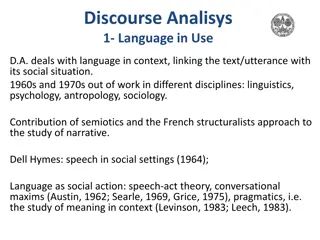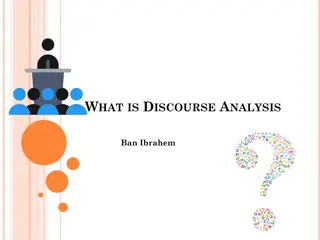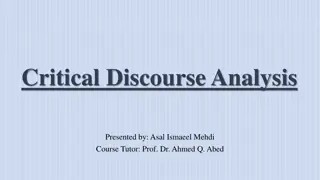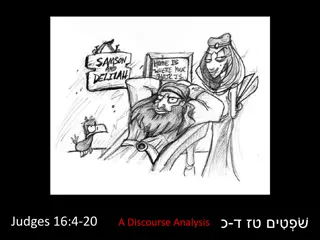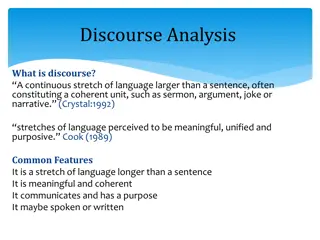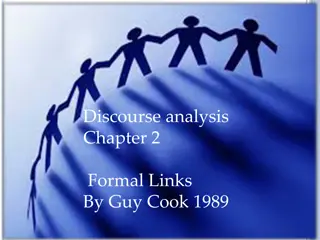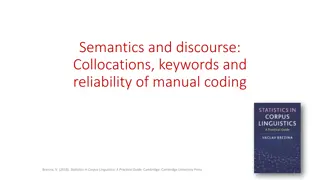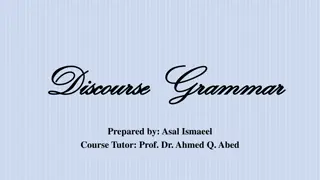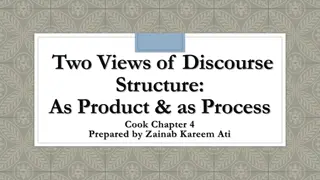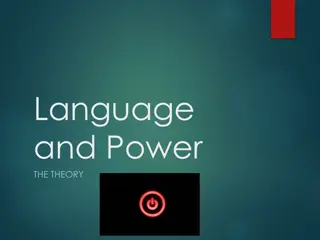Understanding Transitivity in Discourse Analysis by Dalia Nabel
Transitivity in discourse analysis involves the selection of linguistic elements to encode meaning, reflecting mental images of reality. Examining processes like material and mental actions, it explores how language users portray experiences. Simpson's model highlights how speakers and writers construct their mental images through language, reflecting their perception of the world. With examples like "The thief killed the woman by a knife," the analysis delves into actor-goal relationships and recipients in the context of transitivity.
Download Presentation

Please find below an Image/Link to download the presentation.
The content on the website is provided AS IS for your information and personal use only. It may not be sold, licensed, or shared on other websites without obtaining consent from the author. Download presentation by click this link. If you encounter any issues during the download, it is possible that the publisher has removed the file from their server.
E N D
Presentation Transcript
TRANSITIVITY SYSTEM TRANSITIVITY SYSTEM Discourse Analysis Discourse Analysis By Dalia Nabel
In systematic functional grammar of Halliday ( defines as the process of making meanings is simply a process of selecting certain elements from the linguistic system and excluding others as opting for other elements may well create different meanings ) Transitivity Transitivity is the set of options relating to cognitive content, the linguistic representation of extra linguistic experience, whether of the phenomena of the external world or of feelings, thoughts and perceptions . All these are studied as parameters to test translation accuracy . It is hypothesized that in order to create a similar mental image in the target-language readers minds . Halliday uses the term Transitivity Transitivity generally refers to the way in which meaning is encoded and presented in a clause.
Simpsons (1993: 88) view that the Transitivity model in discourse analysis shows how language users (be they speakers or writers) encode in language their mental picture of reality and how they account for their experiences in the world around them . This view is adopted in the current study. The Processes Of Transitivity In Transitivity, there are number of processes can be identified as to whether they represent an event, action, saying, behavior, state of mind, state of being or state of existing. With this in mind, these processes can be classified into a number of processes : 1. 1. Material processes Material processes known as processes of doing and happening , there is an obligatory role of Actor filled by the doer of the process, an optional role of Goal filled by the entity affected by the process, and an optional role of Recipient Actor (the doer) + Type of process + The Goal Actor (the doer) + Type of process + The Goal
For Example : The thief killed the woman by a knife The thief (the doer) + killed (process) + woman(Goal) + knife( the material or instrument) in this process, as there are no goods to be given to somebody; there is no Recipient. For example : Just last month, another of its journalists, Yulia Latynina, left the country after she was sprayed with faeces and her car was set on fire.
Yulia Latynina The Actor she The Goal In this sentence her country is foregrounded in attention the endpoint (to somewhere) is backgrounded in attention. she was sprayed with faeces, the Actor is backgrounded in attention. her car was set on fire, where her car is the Affected Participant, and the Actor is backgrounded in attention.
On April 1, the city of Tikrit was liberated from the extremist group Islamic State. . / Iraqi forces (The Actor) + was liberated + Tikrit ( The Goal) The sentence tensed in passive voice and the Actor (iraqi forces) is backgrounded Islamic state (The Actor) + was occupied + Tikrit (The Goal) Islamic state in this sentence is the Actor and it is foreground in attention
2. Mental processes Unlike material processes, which are concerned with experiences of the material world, mental processes (also known as processes of sensing) represent conscious experiences as they flow from a person s consciousness . Mental processes express a state of mind or psychological events; therefore, they have to do with feelings , thinking, perceiving and wanting, that is, they are internal reactions to different phenomena. Mental processes are classified by Halliday into four types : 1) emotion : love , hate , like 2) cognition : know , believe , understand 3) Perception : see , hear , feel 4) Desideration : decide , want , desire , , , , , , , , In mental processes, there are two participants: A. one is an obligatory role of Senser filled by the entity that feels, thinks, or perceives, B. the other is an optional role of Phenomenon filled by the entity that is felt, thought, or perceived by the Senser.
For Example : The man sawa little girl holding a pair of binoculars. In this sentence , where : the man is the person who saw the young girl with the naked eye (senser) a little girl is what is seen by the man (the phenomena) The verb (saw) the process of sensing . ! In this sentence ,there are Three mental processes 1) where the implicit pronoun she is the Senser, 2) she realized, where the implicit pronoun she is the Senser 3) he discovered, where the implicit pronoun he is the Senser she [Senser] heard [process of sensing] him sniffing fast, repetitive sniffs like someone trying to ascertain the source of a particular smell. She [Senser] realized [process of sensing] that he [Senser] had discovered [process of sensing] a new smell.
3)Verbal processes Verbal processes (also known as processes of saying) include all modes of expressing and indicating. They can be either explicit when verbs such as to say, to tell, to utter, to inform, to express, to complain and so on are used or implicit when verbs such as to show, to indicate, etc. are employed . There are some examples of verbs in this process , such : , , , , , To say, to tell, to utter, to ask, to enquire The sayer+ Verbal + verbiage( what the sayer says)
It can filled the roles by four of participants : 1. an obligatory role of Sayer filled by the addresser 2. an optional role of Receiver filled by the addressee 3. an optional role of Target filled by the entity targeted by the verbal process, 4. and the role of Verbiage filled by the content of what is said or the name of the saying. For Example : )Circumstances (verbiage) : ( ) ( ) The process of saying ( The sayer the emphasis is placed on the completion of the act of saying, while raising his head is a circumstantial element (manner/quality as it answers the question how )in Arabic called the Verbiage of the process, that is, the content of what is said or indicated. The role of Receiver, that is, the addressee, is not expressed explicitly not expressed explicitly by the writer in an attempt to get his readers physically involved in the text interpretation
. : Come along, Pearl! said she, drawing her away. Come and look into this fair garden . . . (p. 95). She (mother is the sayer) + said ( verbal) + Receiver(Pearl) + Verbiage (come along pearl) ( come and look to ) + Circumstances (drawing her away) 4) Behavioural processes Behavioral processes (also known as processes of behaving) reflect psychological behaviors . They can be divided into (1) processes manifesting physiological : to breath , to sleep (2) processes representing bodily postures and pastimes : to sit down ,to sit up (3) physiological processes manifesting states of consciousness :to cry , to sob (4) material processes functioning as behavioral processes. : to chat , to talk , , , ,
Behaver+ Process of behaving + circumstances Aziza started to breathe loudly, . Aziza ( the behaver)+ breath (the process of behave) + loudly( the circumstances ) 5) Relational processes 1) Relational processes are typically realized in the verb to be or some verbs of the same class, such as to seem, to grow, to feel, to remain, to keep, 2) whose function is experiences in terms of being or having rather than doing, behaving, saying or sensing In other words, these processes enable language users to characterize, describe, identify, define and classify some details of the picture conjured up in their minds. By doing so, they will be able to relate one fragment of experience to another.
the relational process is to characterize or describe. There are two participants )Carrier and Attribute(. However, when the relational process is identify or classify, then there are two participants, namely Identified and Identifier. When the two participants (Identified and Identifier) are reversible, then the relational process is a process of identifying. when the two participants(Carrier and Attribute) are not reversible, the relational process is attributive. Relational processes, whether identifying or attributive, can be classified into three main types : A. Process of being : expressed by verb to be + adj , such She is/was clever , rich in Arabic ( ) / B. Process of being at/in/with : expressed to be followed by a prepositional phrase ,such She is/was at home , with her mother . In Arabic ( / ) C. Process of having: expressed by verbs such as to have, to own, to belong to, ect . Such I have three kids , this book belongs to Sarah .
In Arabic like : In Arabic like : / A Muslim woman has the full right to approve or deny a proposal of marriage . . . . Muslim woman( the possesor) + has ( process of having) +full right to approve or deny a proposal of marriage (Attribute/Possessed.)
6) Existential processes Existential processes (also known as processes of existing) are typically realized by the verb to be or some other related verbs, such as to exist, to remain, to arise, to occur, to happen, to take place, to come about . In Arabic like : ) ( ) ( ) ( Existential processes typically have one obligatory participant, labelled Existent, which can represent a wide range of referents, including a thing, person, object, institution, abstraction, action and event . For example : there s something specifically important in this particular story which is being overlooked as a result of all the lazy journalism around it
